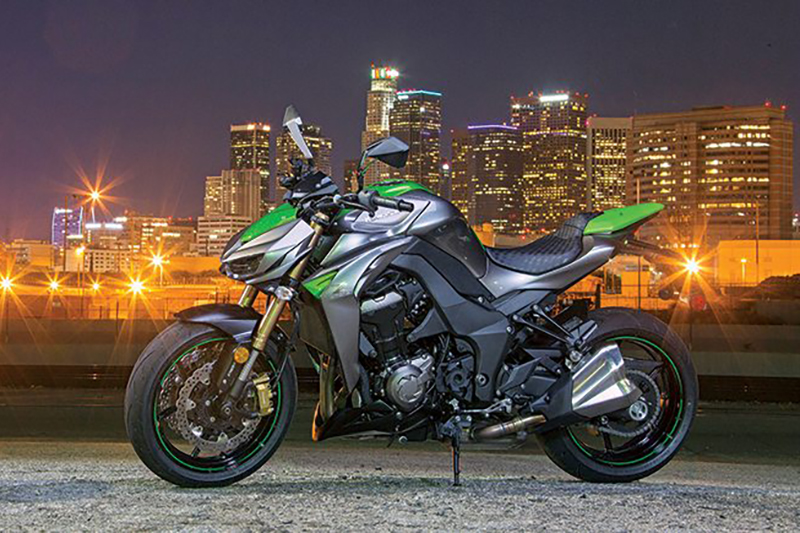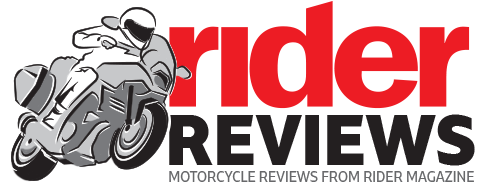2014 Kawasaki Z1000 ABS

Road Test Review
Though called a streetfighter, the Kawasaki Z1000 ABS, which has been thoroughly reworked for 2014, is a far cry from battle-scarred sportbikes that have been ridden hard and wrecked, their mangled bodywork chucked into the dumpster and their clip-ons replaced with a motocross handlebar. Real streetfighters, like the pugnacious pugilists they’re named after, are often hideous, little more than an engine wrapped in duct tape and shattered dreams. The sculpted Z1000, on the other hand, is straight out of a comic book, something the Green Goblin might ride on the rain-slick streets of a decaying metropolis. Consider me a fanboy of the Z’s radical new look.
Beneath the head-turning bodywork is a highly refined, wickedly fast machine. Sharing a platform with the Ninja 1000, a fully-faired, street-oriented sportbike also updated for 2014 (Rider, January 2014), the Z1000 is powered by the same liquid-cooled, 1,043cc, DOHC, 16-valve in-line four. Revised intake cams with less lift and duration and new cylinder-connecting passageways that reduce pumping losses contribute to higher performance throughout the rev range. Jett Tuning’s dyno recorded 127 horsepower and 74 lb-ft of torque at the rear wheel—about the same peak figures as the previous model but there’s a 2-5 percent gain across the midrange (Rider, April 2010). Kawasaki focused less on squeezing every last bit of power out of the engine and more on enhancing the aural and visceral experience. New intake passages and a 16-hole airbox resonator sharpen the Z1000’s howl. Revised ECU settings, equal-length velocity stacks and balance tubes connecting the exhaust headers sharpen throttle response. The 2014 Ninja 1000 got engine modes and traction control to make it a better sport tourer, but given the Z1000’s harder-edged mission statement, it got more aggressive tuning and shorter gearing instead.
Throttle response can be abrupt at low speeds and high-pitched vibration creeps in above 7,000 rpm, but otherwise the Z1000’s counterbalanced engine is a model of civility. Throttle response is direct, power delivery is linear and driveline lash is minimal. A slightly taller sixth gear ratio helps the bike cruise smoothly at highway speeds, and we averaged a respectable 35 mpg during our 1,000-mile test, good for 157 miles from the larger 4.5-gallon tank (up from 4.1). Working the clutch is an easy, two-finger affair and gear changes are practically telepathic.
The twin-spar aluminum frame and cast aluminum swingarm are unchanged, but a lower-friction steering stem seal lightens steering and a lighter, narrower aluminum subframe further centralizes mass. The Z’s sporty steering geometry and 32.1-inch seat height were left alone, but its ergonomics were made more aggressive with a less-upright handlebar. Although not as committed as a full-on sportbike, the Z1000’s somewhat crouched riding position, along with its hard seat and lack of wind protection, favors brief sorties over protracted battles.
Chassis improvements include a new 41mm Showa SFF-BP (Separate Function Fork-Big Piston) male-slider fork with spring preload adjustment in the left leg and stepless compression and rebound adjustment in the right. The fork resists diving under heavy braking and is well damped. Unfortunately, the rear shock, which has long been the Z1000’s weak link, is comparatively harsh. Rear suspension travel has been reduced from 5.4 to 4.8 inches, and the horizontal back-link rear shock has firmer settings and a more progressive lever ratio. Rear preload and rebound are adjustable, but the high compression damping is fixed. Fine and dandy on smooth pavement, but the rough stuff unsettles the chassis and sends jolts up your spine. New 4-piston, radial-mount monobloc front calipers with high-friction pads give the brakes more initial bite, better stopping power and good feel at the adjustable lever, and ABS is now standard. Lighter, 6-spoke cast aluminum wheels reduce unsprung weight by 3.3 pounds and wear grippy Dunlop Sportmax D214 tires developed specifically for this bike. Notwithstanding the rear shock, the chassis is a solid package and the Z1000 makes short work of curvy roads.
Now in its fourth generation, the Z1000 has evolved into a muscular, cohesive machine. The new styling may be an acquired taste, but many details are undeniably cool, from the reflector-less LED headlights and cast aluminum mirror stays to the dual-element tachometer, which uses a vertical bar graph on the LCD display up to 4,000 rpm and bright white and red LEDs arrayed horizontally along the top from 4,000 rpm up to redline. With a smooth, powerful engine and sportbike-caliber brakes and suspension, the Z1000 is ideal for go-fast day rides or urban commuting, squirting out of corners and through traffic like a greased pinball. For serious sport-touring duty the Ninja 1000 is the better choice, but with a set of soft luggage and a strap-on tankbag, the Z1000 makes a great weekend road warrior.
CORRECTION (9/10/14): The original version of this story, and the one that ran in the April 2014 issue of Rider, stated that the butterfly valve in the exhaust system had been eliminated, as per Kawasaki’s press materials. That turned out to be incorrect (as confirmed by a Kawasaki representative), so the story above has been corrected.
